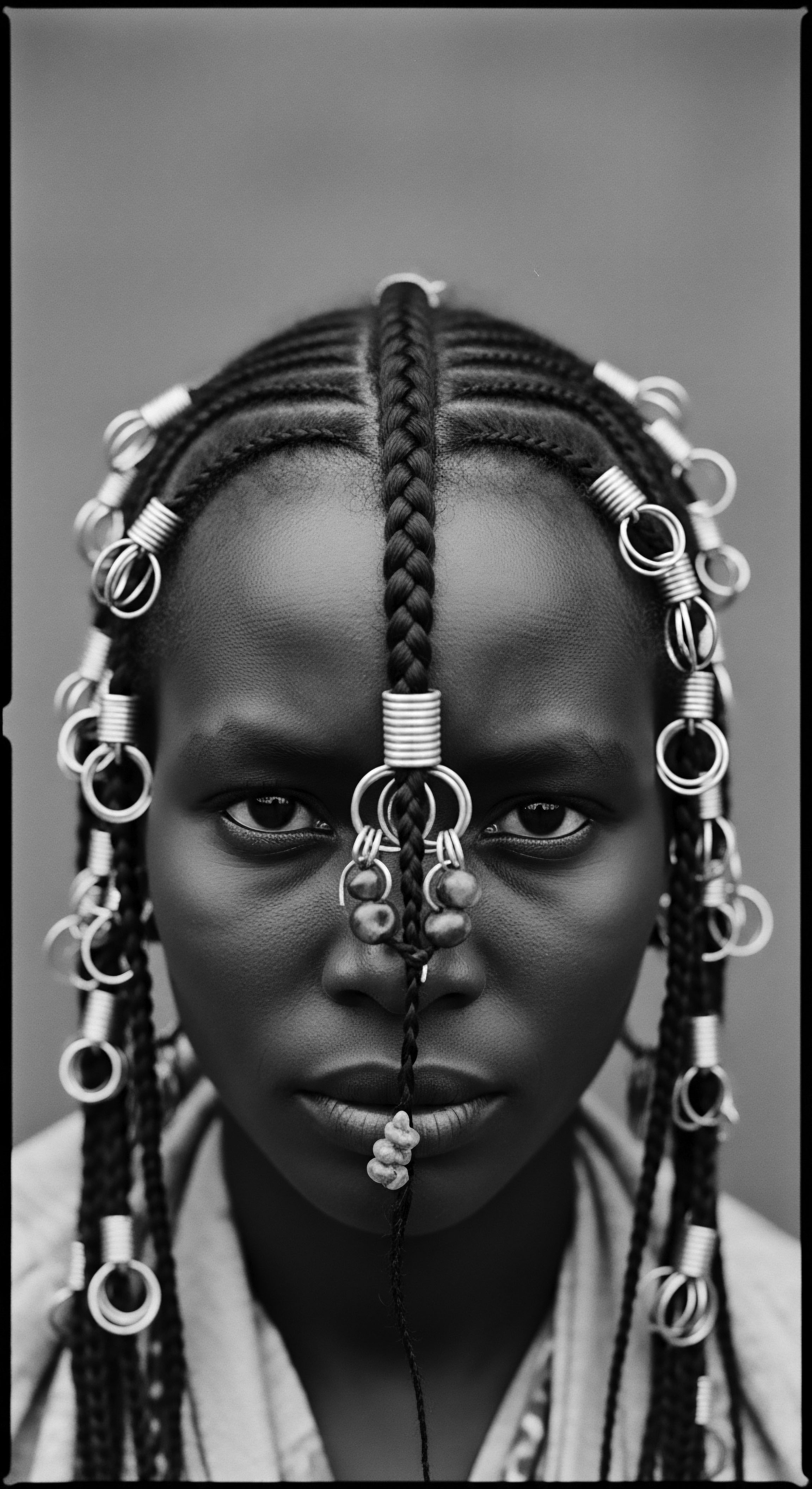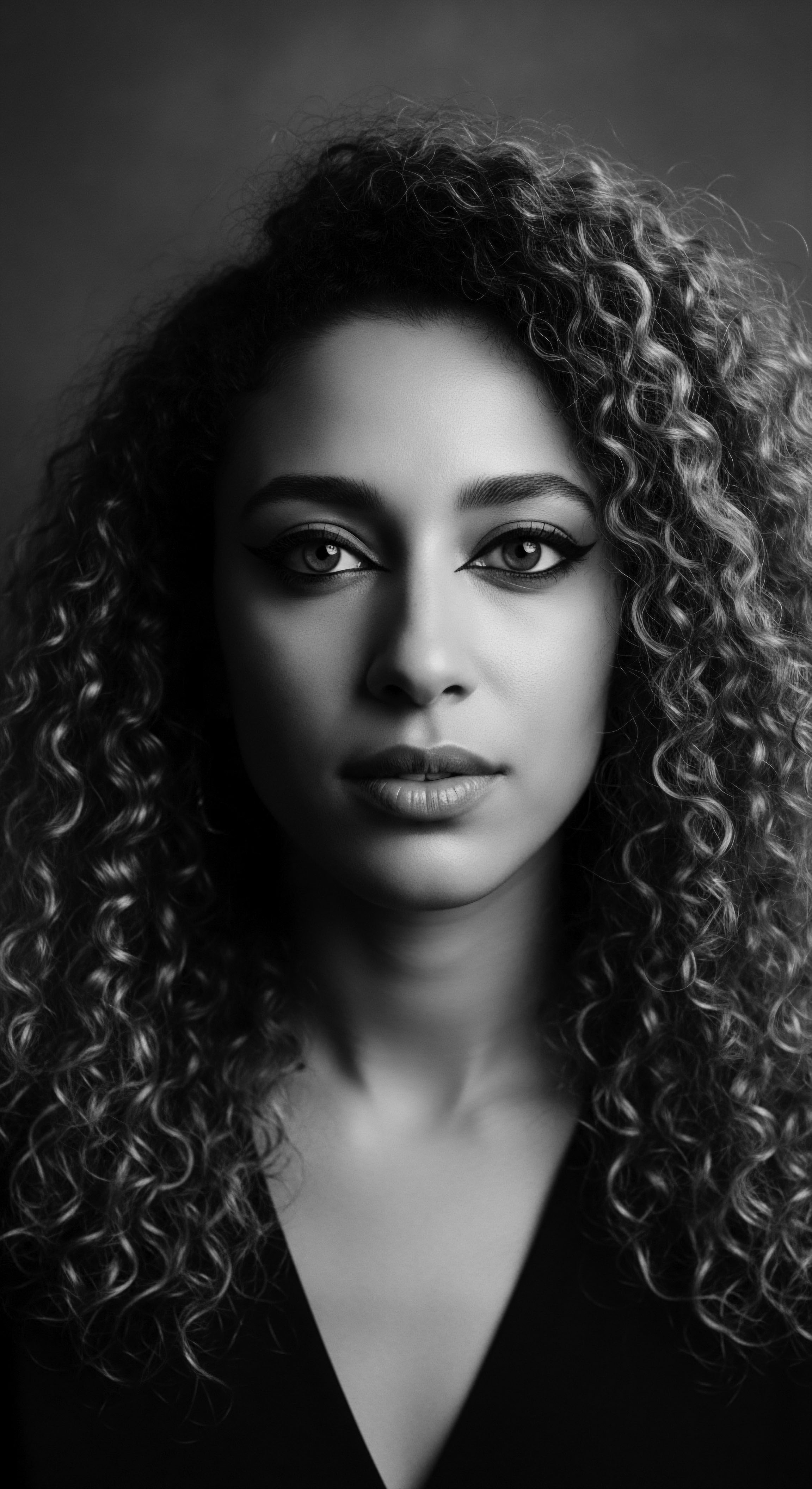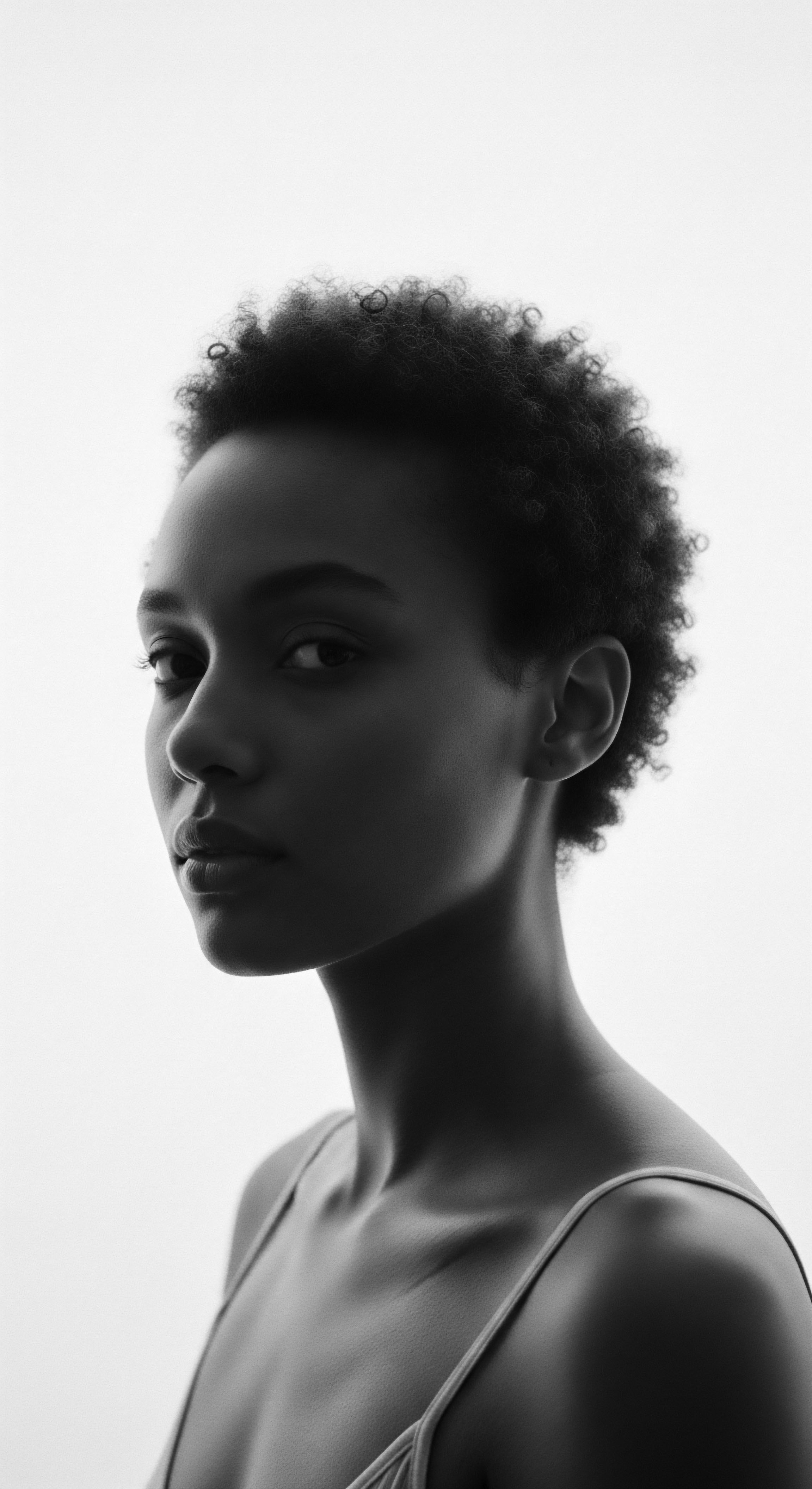
Roots
To truly understand the story of hair moisture in African communities, one must listen for the echoes from the source, tracing strands of heritage back to their very beginnings. It is not a tale of fleeting trends, but a profound connection to earth, spirit, and survival. For those with textured hair, this history runs deeper than individual experience; it resides in the very helix, a coded memory of ancestral ingenuity and resilience.
The journey to keep these coils and curls vibrant, supple, and strong began long before modern laboratories, rooted instead in the fertile soils and abundant plant life of a vast continent. This collective wisdom, passed from elder to child, mother to daughter, formed the bedrock of care, transforming elemental resources into potions of protection and beauty.

Anatomy of a Heritage Strand
Textured hair, with its unique helical structure, presents particular needs for moisture retention. Its coils and curves create more points for moisture to escape compared to straight hair, requiring diligent care to maintain hydration. The ancestral understanding of these inherent characteristics, though not articulated in contemporary scientific terms, was nonetheless profound.
Communities recognized the tendency for dryness and devised regimens that acted as a shield, locking in precious water from the elements. This ancient wisdom, observing the very biology of the strand, led to the discovery and consistent use of natural emollients.

What Traditional Ingredients Were Used for Initial Hair Moisture Efforts?
Across Africa’s diverse landscapes, various communities turned to the botanical and animal bounty surrounding them for hair moisture. These early efforts often involved plant-derived oils and butters, prized for their rich fatty acid profiles and ability to seal in hydration. The use of oils to maintain hair moisture is consistent across the continent. These ingredients served not only as conditioners but also as protective barriers against harsh environmental conditions, such as sun, wind, and dust.
Traditional African hair moisture practices reveal a deep understanding of textured hair’s unique needs, long before modern scientific inquiry.
Shea Butter (from the Vitellaria paradoxa tree) stands as a prominent example, particularly in West Africa. This creamy, yellowish butter has been used for centuries, revered not merely for its moisturizing properties but also for its cultural and economic significance, often called “women’s gold” as it provides income for millions of African women. Its composition, rich in vitamins A and E, along with fatty acids, helps improve hair elasticity and provides a natural barrier. Archaeological evidence confirms shea butter production dating back to 100-1700 CE, and its use is even mentioned in records from Cleopatra’s ancient Egypt.
Marula Oil, sourced from the kernels of the marula fruit tree (Sclerocarya birrea) in Southern Africa, represents another key moisturizing agent. For thousands of years, communities like the Tsonga people of South Africa and Mozambique have utilized it as a moisturizer for skin and hair, particularly to guard against dehydration in rough weather conditions. Its fatty acid composition, along with vitamins C and E, contribute to its intensive moisturizing capabilities and easy absorption without leaving an oily residue.
From North Africa, particularly Morocco, Argan Oil, extracted from the kernels of the argan tree (Argania spinosa), has been a prized ingredient. Berber women, among others, have traditionally used it to nourish hair and scalp. High in vitamin E and essential fatty acids like oleic and linoleic acids, argan oil hydrates the hair shaft, seals in moisture, and helps protect against breakage and split ends. Its non-greasy nature allows it to penetrate without residue, making it suitable for daily moisturizing.
Another significant, albeit perhaps less widely known, ingredient is Baobab Oil, derived from the seeds of the iconic Baobab tree (Adansonia digitata). This “Tree of Life,” found across Africa, yields an oil rich in antioxidants and fatty acids, making it a valuable conditioner that hydrates dry, brittle hair and promotes scalp health. Its lightweight nature contributes to its use as a natural moisturizer that adds nutrients.
| Ingredient (Common Name) Shea Butter (Vitellaria paradoxa) |
| Region of Prominence West Africa |
| Key Moisturizing Properties Rich in fatty acids and vitamins A & E; creates a protective barrier; improves elasticity. |
| Ingredient (Common Name) Marula Oil (Sclerocarya birrea) |
| Region of Prominence Southern Africa |
| Key Moisturizing Properties High in monounsaturated fatty acids, Vitamin C & E; provides intensive hydration; absorbs easily. |
| Ingredient (Common Name) Argan Oil (Argania spinosa) |
| Region of Prominence North Africa |
| Key Moisturizing Properties High in Vitamin E, oleic, and linoleic acids; seals moisture; reduces breakage; lubricates scalp. |
| Ingredient (Common Name) Baobab Oil (Adansonia digitata) |
| Region of Prominence Across Africa |
| Key Moisturizing Properties Rich in antioxidants and fatty acids; deeply conditions; hydrates scalp; lightweight. |
| Ingredient (Common Name) Ghee (Clarified Butter) |
| Region of Prominence East Africa (Ethiopia) |
| Key Moisturizing Properties Used to moisturize and seal moisture; strengthens hair due to fat content. |
| Ingredient (Common Name) These traditional ingredients, sourced directly from the land, represent a foundational understanding of hydration for textured hair, a heritage of care passed through generations. |

Ritual
The journey of hair moisture in African communities extends beyond the mere application of ingredients; it encompasses a profound ritual. This ritual, an intricate dance between natural resources and skilled hands, embodies the living traditions of care and community. The transformation of raw ingredients into potent elixirs for textured hair reflects a deep reverence for the hair itself—a reverence tied to identity, status, and spiritual connection. Hair grooming was often a communal activity, strengthening social bonds.

The Sacred Touch
The act of moisturizing hair was rarely a solitary, hurried task. It formed part of a larger ceremony, a moment for connection, storytelling, and the transmission of ancestral wisdom. Mothers shared techniques with their daughters, grandmothers recounted stories while braiding, and community members assisted one another in complex styling practices.
This collective approach ensured that knowledge of ingredients, their preparation, and their specific applications for hair health endured through time. This heritage of shared care underscores the holistic view of well-being, where hair health is intertwined with communal harmony.

How Did Traditional Preparation Methods Enhance Ingredient Efficacy for Hair Moisture?
Traditional preparation methods were not arbitrary; they reflected a sophisticated understanding of how to extract and maximize the benefits of natural ingredients for hair moisture. Processing techniques often involved minimal heat or mechanical methods to preserve the integrity of beneficial compounds.
- Shea Butter Processing ❉ The making of shea butter traditionally involves collecting the fallen fruit, drying, crushing, roasting, and then grinding the nuts into a paste. This paste is kneaded with water, allowing the butter to separate and float, which is then skimmed off and boiled to remove impurities, leaving a pure, solid butter. This meticulous process yields a butter rich in essential fatty acids and vitamins, maximizing its moisturizing capacity.
- Oil Extraction ❉ For oils like marula or baobab, cold-pressing was a common method. This technique preserves the delicate fatty acids, vitamins, and antioxidants that are crucial for hydrating and protecting the hair. Traditional knowledge ensured that the oil retained its therapeutic qualities, acting as a lightweight, deeply nourishing moisturizer.
- Herbal Infusions ❉ Beyond oils and butters, various herbs and plant extracts were incorporated into moisturizing preparations. These might be steeped in water to create rinses or infused into carrier oils to transfer their properties. For instance, some communities might use rooibos tea from South Africa, recognized for its antimicrobial and antioxidant qualities that aid healthy hair growth. The Basara Tribe of Chad applies an herb-infused oil and animal fat mixture, known as Chebe, to their hair weekly for length retention, demonstrating a systematic approach to moisture and strength.
The communal acts surrounding hair care rituals reinforced social bonds while preserving invaluable knowledge of ingredient preparation.

Protective Styles as Vessels for Moisture
Traditional African hairstyles were not solely for aesthetic appeal; they served a practical, protective purpose, often aiding in moisture retention. Braiding, threading, and coiling techniques created encapsulated environments for the hair, minimizing exposure to environmental stressors that could lead to dryness. These styles also allowed for consistent application and absorption of moisturizing ingredients over extended periods.
African Threading, a technique common in West and Central Africa, involves wrapping sections of hair tightly with thread. This practice protects the hair and helps to stretch it without heat, making it easier to apply moisturizers and seal them in, which benefits length retention. Similarly, intricate braiding, a feature of many African communities, functions as a protective style that safeguards hair length and allows for deep conditioning, providing continuous moisture. Women would often grease their hair, a tradition passed down from ancestors, using natural products that keep hair moisturized.
The intentional use of these styling methods in conjunction with natural emollients showcases a sophisticated, holistic hair care system where styling and moisturizing were inseparable elements of well-being. The synergy between traditional ingredients and protective styles created a robust framework for textured hair health, designed to counteract its natural propensity for dryness and breakage.

Relay
The wisdom surrounding traditional hair moisture ingredients in African communities has traveled across generations, a living legacy known as the “Relay.” This continuity of practice and knowledge speaks volumes about the deep-seated value placed on textured hair heritage, its profound connection to identity, and its role in shaping futures. It reflects how ancestral methods are not relics of the past but vibrant components of present-day care, continually reinterpreted and validated through experience and, increasingly, modern scientific understanding.

Intergenerational Wisdom
The transmission of hair care practices was, for countless centuries, an oral and practical tradition. This intergenerational sharing ensured that the intricate knowledge of plant properties, extraction techniques, and application methods for ingredients like shea butter or marula oil persisted. In West Africa, families have passed on their experiences in making shea butter for centuries.
The communal settings in which hair was cared for – often amidst storytelling and shared laughter – reinforced this learning, embedding lessons about hair health within the larger cultural fabric. This dynamic, living archive meant that hair care was not merely about aesthetics; it concerned maintaining a connection to lineage, community, and self.
During the transatlantic slave trade, enslaved Africans were forcibly stripped of many cultural practices, including traditional hair care. Their hair was often shaved, which removed an essential part of their identity. Despite these immense challenges, some practices persisted as acts of resistance and preservation of African identity, influencing the adaptive styles and care routines of the African diaspora. The emphasis on moisturizing oils and natural creams for textured hair continues today, with popular ingredients like shea butter and castor oil having roots in traditional African hair care.

A Modern Lens on Ancient Practices
Contemporary science, with its ability to isolate compounds and analyze their effects, often validates the efficacy of traditional African moisturizing ingredients. What was once understood through generations of observation and experiential knowledge now gains backing from chemical analysis.

What does Contemporary Science Reveal about the Ancestral Methods of Hair Moisture?
Modern research frequently confirms the benefits observed by African communities for centuries.
- Shea Butter’s Emollient Power ❉ Studies show that Shea Butter is rich in triterpenes, tocopherols, phenols, and sterols, besides its high fatty acid content. These compounds contribute to its anti-inflammatory properties and its ability to act as an effective occlusive barrier, preventing trans-epidermal water loss and sealing moisture into the hair shaft. This scientific understanding supports its traditional use for deep hydration and skin protection.
- Marula Oil’s Antioxidant Capacity ❉ Marula Oil contains a high concentration of monounsaturated fatty acids, particularly oleic acid, and a rich profile of antioxidants, including tocopherols and flavonoids. These components protect hair from environmental damage, reduce oxidative stress, and contribute to its remarkable moisturizing and softening properties.
- Baobab Oil’s Nutrient Density ❉ The cold-pressed oil from Baobab Seeds boasts a balanced ratio of oleic, linoleic, and palmitic fatty acids, alongside vitamins A, D, E, and K, and sterols. This composition allows baobab oil to penetrate the hair shaft, providing deep conditioning, supporting scalp health, and strengthening hair follicles against breakage.
- African Black Soap’s Cleansing Balance ❉ While primarily a cleanser, traditional African black soap (made from plantain skins, cocoa pod ash, shea butter, and palm oil) offers a balanced approach to cleansing without excessively stripping hair. Its mineral content and gentle saponifying agents contribute to a cleansed scalp, preparing hair to better receive moisturizing treatments.
The re-emergence of natural hair movements globally has spurred renewed interest in these traditional ingredients and practices. The Liquid, Oil, Cream (LOC) or Liquid, Cream, Oil (LCO) methods, popular for moisture retention in textured hair today, echo the centuries-old practice of layering water-based moisturizers with oils and butters to seal in hydration. This demonstrates a continuity of effective moisture management strategies across time and geography, showing that the principles of ancestral care remain relevant.
| Aspect Core Moisturizers |
| Traditional African Practice Plant butters (shea, cocoa), plant oils (marula, argan, baobab), animal fats (ghee, Chebe mixtures). |
| Modern Parallel/Scientific Understanding Emollients, humectants, occlusives. Fatty acids, vitamins, antioxidants identified as active compounds. |
| Aspect Application Method |
| Traditional African Practice Manual application, scalp massages, layering, integration into protective styles. |
| Modern Parallel/Scientific Understanding LOC/LCO method, deep conditioning, leave-in conditioners. Focus on sealing cuticle. |
| Aspect Cultural Role |
| Traditional African Practice Communal bonding, identity marker, spiritual significance, generational knowledge transfer. |
| Modern Parallel/Scientific Understanding Self-care ritual, connection to heritage, expression of identity. |
| Aspect Hair Protection |
| Traditional African Practice Protective styles (braids, threading), sun/weather barrier. |
| Modern Parallel/Scientific Understanding Minimizing manipulation, heat protection, UV filters, physical barriers (bonnets). |
| Aspect The enduring efficacy of ancestral methods for hair moisture underscores a profound, often intuitive, understanding that continues to resonate with contemporary hair care science. |
A significant, specific historical example of this deep understanding and continued practice comes from the Himba People of Namibia. The Himba women are widely recognized for their distinctive red ochre paste, called Otjize, which they apply to their skin and hair. This mixture is traditionally made from butterfat (often from cow’s milk) and ochre pigment. The butterfat component provides essential moisture and acts as a sealant, protecting the hair from the harsh, arid climate and dust of their environment.
While the ochre adds color and serves as a sunscreen, the butterfat ensures the hair remains supple and protected, illustrating a centuries-old, indigenous solution for hair moisture and maintenance in extreme conditions. This practice, passed down through generations, directly addresses the need for lubrication and moisture retention in a dry climate.
The continuous relevance of these traditional ingredients for hair moisture, supported by both lived experience and scientific inquiry, speaks to a rich heritage. This heritage offers not only effective solutions for textured hair care but also a profound connection to cultural identity, ancestral wisdom, and a more holistic approach to well-being.

Reflection
To contemplate the ancestral ingredients used for hair moisture in African communities is to recognize a profound legacy, a living testament to ingenuity and enduring wisdom. It is a dialogue between the earth’s generosity and human creativity, a conversation spanning centuries that continues to whisper its truths into the present moment. For textured hair, this history is not a distant, academic concept; it is etched into the very core of our being, a part of the ‘Soul of a Strand’ that vibrates with resilience and beauty.
These traditional practices, deeply rooted in the rhythms of nature and the bonds of community, offered more than superficial hydration. They provided protection against the elements, strengthened the hair fiber, and, in a significant way, preserved identity and connection. The simple, raw materials of the African landscape – the rich butters of shea and cocoa, the precious oils of marula and argan, the versatile baobab – became vessels of care. They carry forward stories of survival, artistry, and a deep respect for the hair as a sacred adornment, a canvas for expression, and a symbol of lineage.
In understanding these historical approaches to hair moisture, we gain a fuller appreciation for the journey of textured hair. It is a journey of reclaiming narratives, honoring the wisdom that preceded us, and recognizing that true hair wellness often resides in the simplicity and purity of nature’s gifts, guided by the ancestral hands that first discovered their power. This legacy continues to shape how we view and nurture our textured strands, grounding us in a heritage that is as radiant and robust as the ingredients themselves.

References
- Sellox Blog. Ancient African Hair Growth Secrets For Healthy Hair. 2021.
- AASAI. Marula Oil – face & body oil for your rituals.
- ByErim. Argan Oil for Hair ❉ Everything You Need to Know. 2021.
- Ammaterre. Marula Oil.
- AmyGalper. Marula Oil ❉ Everything You Need to Know. 2024.
- Native Wild Living. 100% Organic, ‘Traditional Method’ Argan Oil.
- Discovering the Origins of Shea Butter – A Journey to the Heart of Africa. 2024.
- Equi Botanics. 7 Surprising Reasons You Need Marula Oil For Your Hair.
- Locs Styles, Loctitians, Natural Hairstylists, Braiders & hair care for Locs and naturals. Argan Oil ❉ North African Beauty Secret for Healthy Hair. 2010.
- Clariant. Plantasens Argan Oil Virg. 2021.
- Omez Beauty Products. The Cultural Significance of Natural Hair. 2024.
- Unveiling the Enchanting Hair Care Rituals of South African Cultures. 2024.
- Tea’s Nature. The History of Shea Butter. 2020.
- Historical Perspectives on Hair Care and Common Styling Practices in Black Women. 2025.
- Al Arabiya. Traditional beauty secrets of North African Berber women. 2016.
- Reddit. No raw oils and butters vs. Traditional African hair care? 2021.
- African Beauty and Skincare ❉ A Deep Dive into History, Traditions, and Natural Ingredients. 2025.
- PsychoHairapy. Our Hair ROOTS ❉ Incorporating our Black Family Hair Traditions and Routines as a Coping Technique to Increase Positive Mental Health. 2024.
- ARKIVE© Headcare. Baobab Oil for Healthy Hair ❉ Uses & Benefits. 2023.
- Baraka Products. Complete Natural Summer Skincare Guide ❉ African Butters & Oils for Every Need. 2025.
- Hair Care Practices from the Diaspora ❉ A Look at Africa, America, and Europe. 2025.
- Nature In Bottle. Baobab Oil Organic African – Adansonia Digitata Seed Oil.
- Holy Curls. Why is baobab oil great for curly hair? 2021.
- The Wonderful Cultural Significance Of Afro Hair Impact On Beauty Trends. 2023.
- NewsBytes. Master traditional African hairstyling techniques like a pro. 2024.
- Roseborough, I.E. & McMichael, A.J. Hair Care Practices in African-American Patients. Seminars in Cutaneous Medicine and Surgery, 2009, 28(2), 103–108.
- متجر زبدة الشيا. What Is Shea Butter? 2024.
- Tattvalogy. Baobab Oil ❉ Nature’s Gift for Radiant Skin and Luscious Hair. 2023.
- Africa Imports. Traditional African Secrets For Long And Healthy Hair.
- Jules Of The Earth. Baobab Oil ❉ Africa’s Ancient Beauty Secret for Radiant Skin and Hair. 2023.
- African Extracts Rooibos Skin Care. Trust in the power of plants. 2021.
- DermNet. Hair care practices in women of African descent.
- Quora. What do I do to manage my African hair? 2012.
- Obscure Histories. The Globalization of Shea Butter. 2024.
- Ahmed, R. Cosmetopoeia of African Plants in Hair Treatment and Care ❉ Topical Nutrition and the Antidiabetic Connection? MDPI. 2024, 16(2), 96.
- Ahmed, R. Cosmetopoeia of African Plants in Hair Treatment and Care ❉ Topical Nutrition and the Antidiabetic Connection? ResearchGate. 2024.
